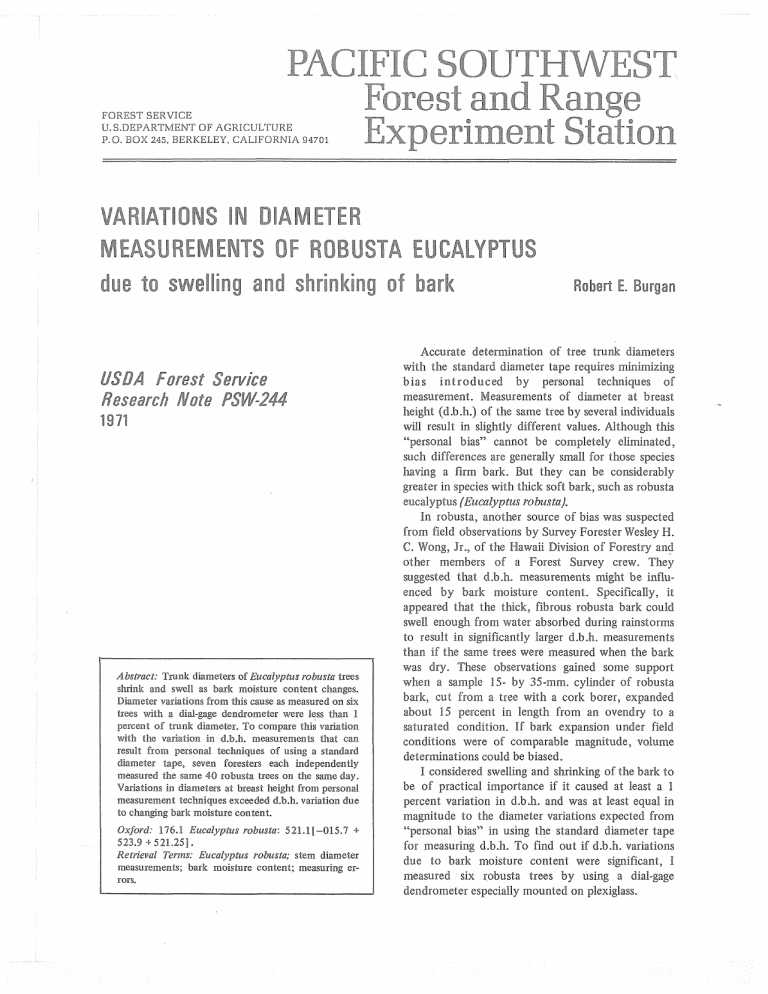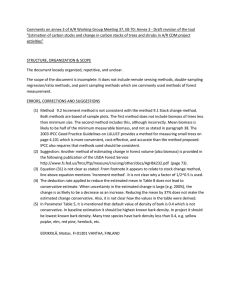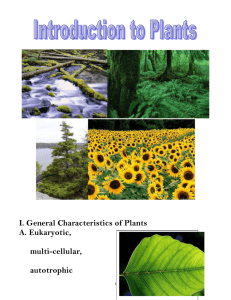G SOUTH EST swe
advertisement

G SOUTH EST
FOREST SERVICE
U. S.TIBEPARTMENT OF AGRICULTURE
I?. 0.EOX 245, BERKELEY, CALIFORNIA 94701
MEASUREMENTS OF ROBUSTA EUCALYPTUS
due to swe ing and shrinking o
USDA Forest ServiGe
Research Note PSW-244
1971
percent of trunk diameter. To compae this vaatlion
with the vafiation in d.b.h. measurements that can
result from persona4 techiques of using a standard
aameter tape, seven foresters each independently
measured the same 40 robusta trees on the same day.
Vsrriations in diameters at breast height from personal
measurement techiques exceeded d.b.h. v a ~ a t i o ndue
to chan@mgbark moisture content.
vaE Terms: EucaEyphs robusfa; stem diameter
remenls; bark moisture content; measuring er-
Robert E. Burgan
Accurate determination of tree trulnk diameters
with the standard diameter tape reqires minimizing
bias i n t r o d u c e d by personal techiques of
measurement. Measurements of diameter at breast
4neight (d.b.h.1 of the same tree by several individuals
will result in slightly difkrent values. Mthough this
""personal bias" cannot be completely eliminated,
such differences are generally small for those species
having a firm bark, But they can be considersbbly
greater in species with thick soft bark, such as robusta
eucalyptus (Eucalyptus robus&).
In robusta, another source of bias was suspected
from field observations by Suwey Forester Wesley H.
C. Wong, Sr., of the Hawaii Division of Foresby and
other members of a Forest Sumey crew. he;
suggested that d.b."n measurements ~ g h be
t inlluenced by bark moisture conkent. Specifically, it
appeared that the thick, fibrous robusta bark could
swell enough from water absorbed during rainstorms
to result in significantly larger d.b.h. measurements
than if the same trees were measured when the bark
was dry. These observations gained some support
when a sample 15- by 35-mm. cylinder of robusta
bark, cut from a tree with a cork borer, expanded
about 15 percent in length from an ovendry to a
sturated condition. If bark expansion under field
conditions were of comparable magnitude, volume
determinations could be biased.
I considered swelling and shrinkkg of the bark to
be of practical importance if it caused at least a 1
percent variation in d.b.h. and was at least equal in
magnitude to the diameter variations expected from
""personal bias" in using the standard diameter tape
for measuring d.b.h. To find o u t i f d.b .h. variations
due to bark misture content were significant, 1
measured six robusta trees by using a dial-gage
dendrometer especially mounted on plexiglass.
-
THE STUDY
The six robusta trees selected for the measurement varied in diameter from 10 to 46 inches, They
were on the Honolulu. Forest Reserve, next to the old
Pali l-ligh~~ay,
at I >200feat elevation, Anfltial rainfall
there averages 5 18 inches. Wet-dry cycles ranged Gsnr
2 to 6 weeks, Measurements were begun after the
weather turned dry. They were made daily during the
remainder of the dry period and through a wet period
t hatfollov~ed,
The onset o f wet cycles was rapid, and rainfall was
continuous enough so the transition from dry to wet
bark occurred within a few hours. Dry bark was
defined as bark that felt dry to the touch; wel bark
was defined as that from which water could be
squeezed.
At the beginning of a measurement period, I used
a diameter tape to measure the "base dhe%q.99
of each
tree to the nearest 0,1 inch., Subsequent changes in
bark thickness were measured with a dial-gage dendrometer, on both the uphill and d o w M 1 sides of
each tree, and added algebraically lo the "base
d,b,h." to determine the new t3.b.h.
The techaique of measuring bark thickness variation with the dial-gage dendrometer was as follows:
Thee nails were driven through the bark and into the
wood of each tree, in a triangclar configuration, on
both the uphill. and dow~iiiil1sides, This configuration
provided a fixed plane from which variations in bark
thickness could be measured, About 1 square inch of
bark, at the center of each triangle, was tri~mgsiedto
form a vertical plane,
The dial-gage was mounted on a 114-inch thick
plexiglass plate (12, 1)- The heads of the nails dri.~en
into the trees fit into holes in the plexiglass base so
bark t ~ c k n e s swas always measured at exactly the
same glace, The gage v~ascalibrated to 0,001inch, A
1/2-inch square s f plesgcass, mounted on the foot of
the spindle, provided a flat surface with which to
eontactthe prepared bark surface, thereby n4nimizing abrasion,
Three bolts were mounted in a second plexiglass
plate so the bolt heads would fit into t h e e holes In
the base plate of the dial-gage. These bolts provided a
means of insuring that the dial-gagwwas propedy
adjusted,
The null hypothesis tested was that the rnaxi-inurn
differences between the diameters, for wet and dry
bark, did not differ signiGcaantly from zero,
The second phase of the study determined the
variations in d.b,h. measurements .$hat could be
attributed to differences in personal techniques of
using a. standard diameter tape. To carry out tEs
phase, seven foresters independently measured d.b.h.
to I f 10inch of the same 40 robusta trees on the same
day. This work was part of the normal routine for
two of the seven foresters. And measuring was done
during a period of dry weather, The trees varied in
diameter from 6 $0 24 inches.
The standard deviation of measurement differences among the seven foresters was calculated for
each tree and plotted over the average d,b.h, The
maximurn observed d,b,h, variation due to swelling
and sbsink.ing of the bark was plotted on the same
graph for comparison (j$g. 2).
'Ihe largest diameter variation due to swelling and
shrinking o f the bark of the six. test trees was 0,139
inch, This variation occurred on a 24-inch diameter
tree having 3-6-inch thick bark (double bark thickness: 7 2 inches) at breast hei@~t,The largesttree (46
Figure 1-A dial-gage dendrometer
to measure diameter change was
positioned by rhree rwils driven
into the robusta tree* The one-.-ha[.
inch square of piexiglass mounted
on the foot of the spindle minimized abrasion o i the bark during
p!acement and removaL
.32
Two standard deviations
1
2 '24
.c
C;
eosurement technique differences
L
.'-.
C
.*
.-
ne standard deviation
.I 6
L.
9
-G
g .*B
Figure 2=Magrritude *of d b,h. variali0e;~n0f r0busta ee~a@ptustrees
due to swelling and shrir~king of the
bark compared $0 dilferences in
d b.h, measurements resul~ng@om
individual techniques of using a
diameter tape*
;5
d. b. h. (inches)
inches d,b,h.) had a single bark thickness 06 1 inch
and a mmi~numdiameter variation of 0,085 inch.
Measurements of the 40 trees by seven foresters
resulted in tree diameter differences ranging from 0.1
to 0.5 inch for 39 of the 40 trees; the diameter
difference for the remgning tree was 0.7 inch. The
diameter differences averaged 032 inch. The range of
diameter differences for the two foresters who
measure tree diameters as part of their normal work
routine was 8 to 0-3 inch, averaging 0,12inch, These
measurement differences are due in large part to the
softness of irobusta bark, Some of the seven foresters
pulled harder on the diameter tape than others, with
the result that their diameter measurements were
consistently smaller.
Maximum variation due to swelling and shrinking
of the bark was less than the diameter variation due
to personal measurement techniques ('g2).Diameter
variation due to swelling and skinking of the bark
never exceeded I percent of the tree db,h, This
amount is much less swelling and shinking than was
observed in the drying and wetting of the 15- by
35-mm, bark cylinder, One reason for this difference
is that the cylinder of bark was ovendried whereas the
bark on the trees was air-dried. Another possibiEty is
that when the bark is intact on the tree, expansion
and contraction with varying moisture content is
restrained by the interwoven and ""iterlocked" nature of the bark fibers.
Variation of robusta bark thickness with changing
moisture content is statistically significant, but is not
great enough to be of practical importance, If proper
techaiques are used, accurate d,b.h, measurements of
robusta depends more on a standard pu11 or tension
of the diameter tape than on the moisture content of
the bark,
Aeknov~ledment:Herbert k.Wick, formerly with
the Station% sresearch staff in Honolulu, Hawaii, and
now Supervisory Forester, Burns Ranger District,
Malheur National Forest, Burns, Oregon, wrote the
study plan, started this studyg and designed the
plexiglass base for the dial gage,
The Author
ROBERT E,BmGm-joined the staff of the Station's Instiedte of Pacific
Idands Forestry, Honolulu, Hawaii, in 1969. Re received bachelor's (1963)
and master's (1966) degrees in forestry at the University of 8vfontan.a.
U.S. Forest Service research in Hawaii
is conducted in cooperation with
Division of Forestry
Ravm.ii Depadment of Land and Naturd Resources
"
The Forest Sewice of &e U.Se Dep
. . . Conducts forest and rmge research at more than 75 Ioea~onsfrom Puerto Rim to
Alaska and HawAkiii.
. . . Pw~ekiiipates~ 4 t hall State forestq agencies in cooperative p r o g a s to p r o t ~ hmd
. hprove the Nation's 395 maion acres of State, l w d , m d private forest lands.
. . . Mmages md protects the 187-m2lisnn-acre N a ~ o n a Forest
l
System for sustained yield
of its mmy products and services.
Tk Padfic Southwest Forest m d Rmge Experiment Stagon
represents the reseach brmch of the Forest Sewice in Cdifomia and Hawaii.
GPO 981-357




